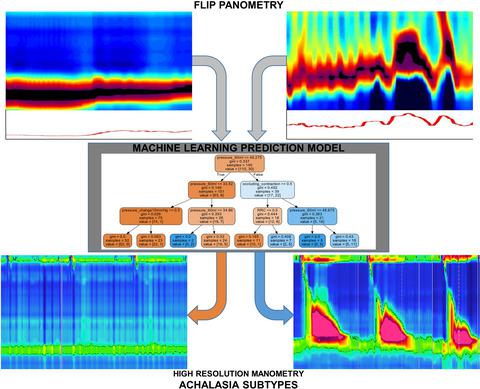当前位置:
X-MOL 学术
›
Neurogastroenterol. Motil.
›
论文详情
Our official English website, www.x-mol.net, welcomes your
feedback! (Note: you will need to create a separate account there.)
Achalasia subtypes can be identified with functional luminal imaging probe (FLIP) panometry using a supervised machine learning process
Neurogastroenterology & Motility ( IF 3.5 ) Pub Date : 2020-07-01 , DOI: 10.1111/nmo.13932 Dustin A Carlson 1 , Wenjun Kou 1 , Katharine P Rooney 1 , Alexandra J Baumann 1 , Erica Donnan 1 , Joseph R Triggs 1 , Ezra N Teitelbaum 2 , Amy Holmstrom 2 , Eric Hungness 2 , Sajiv Sethi 3 , Peter J Kahrilas 1 , John E Pandolfino 1
Neurogastroenterology & Motility ( IF 3.5 ) Pub Date : 2020-07-01 , DOI: 10.1111/nmo.13932 Dustin A Carlson 1 , Wenjun Kou 1 , Katharine P Rooney 1 , Alexandra J Baumann 1 , Erica Donnan 1 , Joseph R Triggs 1 , Ezra N Teitelbaum 2 , Amy Holmstrom 2 , Eric Hungness 2 , Sajiv Sethi 3 , Peter J Kahrilas 1 , John E Pandolfino 1
Affiliation

|
Achalasia subtypes on high‐resolution manometry (HRM) prognosticate treatment response and help direct management plan. We aimed to utilize parameters of distension‐induced contractility and pressurization on functional luminal imaging probe (FLIP) panometry and machine learning to predict HRM achalasia subtypes.
中文翻译:

贲门失弛缓症亚型可以通过使用监督机器学习过程的功能性腔成像探针 (FLIP) 全景测量来识别
高分辨率测压 (HRM) 的贲门失弛缓症亚型预测治疗反应并帮助指导管理计划。我们旨在利用功能性管腔成像探针 (FLIP) 全景测量和机器学习中的扩张诱导的收缩性和加压参数来预测 HRM 贲门失弛缓症亚型。
更新日期:2020-07-01
中文翻译:

贲门失弛缓症亚型可以通过使用监督机器学习过程的功能性腔成像探针 (FLIP) 全景测量来识别
高分辨率测压 (HRM) 的贲门失弛缓症亚型预测治疗反应并帮助指导管理计划。我们旨在利用功能性管腔成像探针 (FLIP) 全景测量和机器学习中的扩张诱导的收缩性和加压参数来预测 HRM 贲门失弛缓症亚型。











































 京公网安备 11010802027423号
京公网安备 11010802027423号